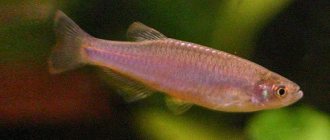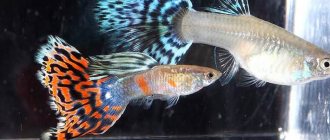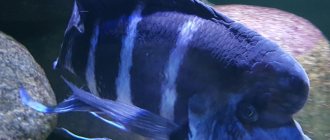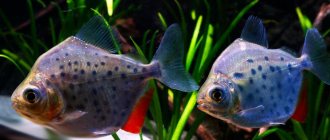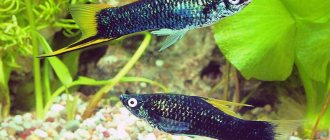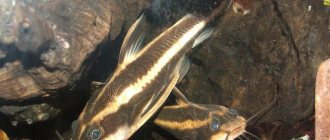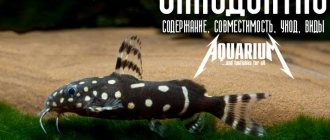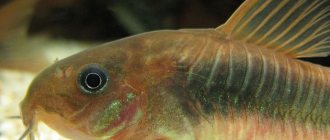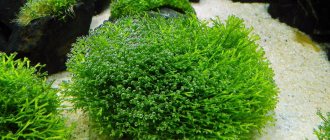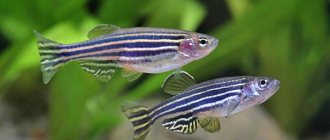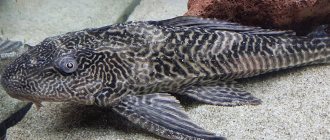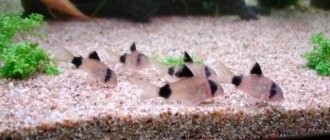Labyrinthine
Cockerel
Labyrinth fish are common among aquarists and are valued for their unpretentiousness and the absence of the need to organize additional aeration in the aquarium. Most representatives of labyrinths have bright colors and luxuriously shaped fins. They are also respected for their calm and peaceful disposition.
Labyrinth fish can live in small amounts of water. Representatives of the group are able to breathe external air by swallowing it through their mouths. In this case, the air should be warm and humid.
What is a labyrinth?
Everyone knows that fish breathe using gills. They pass water through this organ, taking oxygen from it. But some species differ from the general mass in the structural features of the body and the way they breathe. These are labyrinth fish that have an accessory respiratory apparatus.
In the process of evolution, some species developed a special organ, which is commonly called a labyrinth. This is a group of plates of bone tissue, which is densely intertwined with blood capillaries. The labyrinth organ is located on both sides of the head, near the gills. The presence of this organ in a large group of fish species allowed scientists to combine them into one group and call it Labyrinthidae.
In order for air to get into the labyrinth, the fish has to come to the surface and swallow air. It is this feature of the body that allows labyrinths to live in bodies of water with low oxygen levels. If there is clean water with a high oxygen content in the aquarium, but the fish do not have access to air, they will die.
It is important to remember that the adnexal respiratory apparatus is formed only 2-5 weeks after birth. Fry, unlike adults, need clean, oxygenated water.
Labyrinth fish have a calm disposition (with the exception of Siamese bettas), but can be aggressive during the spawning period. All species in this group prove to be excellent parents and take careful care of their offspring. The male is able to build a foam nest from air bubbles, which he places in the thick of algae. The structure is attached using mucus. This is where the eggs will be located.
Siamese cockerels during mating games.
All labyrinths have parental instincts. This is especially true for males. They take especially careful care of their offspring and jealously protect them.
Some representatives live exclusively in special water chemistry, but all labyrinth fish need warm, moist air above the surface of the water.
Feeding
Most representatives of the Creepers family are carnivores, but do not refuse plant foods. Therefore, live food should make up at least a third of their diet. It could be:
- bloodworm;
- tubifex;
- Artemia nauplii;
- cortera;
- gammarus;
- Cyclops.
You can diversify their diet with spirulina tablets and ready-made flake industrial feeds. But some species of gourami, cupanus and ctenopus should eat exclusively protein foods.
This also applies to some extent to macropods, cockerels, and laliuses, but these varieties will not refuse dry ready-made mixtures.
Labyrinth fish can eat in any layer of water, so both floating and sinking food are suitable for them, but it is not recommended to arrange surface feeders, since the males will immediately begin to build nests on them for spawning. Residues of feed should be removed promptly so that organic residues do not begin to decompose. For adequate nutrition, it is enough to give fish enough food once a day so that they eat it within 5-7 minutes.
Cockerel
This species tops the list of the most common and unpretentious labyrinth fish. Thanks to many years of selection, there are many forms on sale that differ not only in color, but also in the shape of their fins. There are about seventy breeds.
The most favorable conditions are a tank with a volume of 20 liters or more. It should have a lot of shelters and living plants. When combining with other species, it is important to take into account the similarity of water parameters and maintenance conditions.
The minimum volume of the reservoir is 5-10 liters. You need to install a filter in the aquarium and plant plants. Setting up the biobalance is very important, as this will simplify caring for your pet.
A distinctive feature of cockerels is their disgustingly quarrelsome character. Thanks to him, all types of cockerels are classified as so-called fighting cockerels. Male cockerels always fight among themselves when they meet. If a female is present nearby, then she too will be attacked and can be seriously injured. For this reason, cockerels are placed in a small aquarium one at a time.
If two males of the same size meet, they begin to demonstrate the size of their fins and the brightness of their color. After some time they start a fight. They open their mouths wide and bite the enemy's body. The male who has won does not allow the opponent to the surface of the water so that the latter cannot take a breath of air. As a result, the defeated cockerel dies.
You should know that two males will not get along in one body of water, even if the aquarium is very large. They will conflict over territory and females. Also, some males may show aggression towards the female during the spawning period if she is not to her liking.
In one aquarium, a betta will not get along with slow, small and veiled fish of other species. If a goldfish lives in a pond, then you shouldn’t put a cockerel there. Also, the species is incompatible with cichlids and other labyrinths. Cockerels simply eat small snails, and pinch off the whiskers of large ones.
You can live with speckled catfish, zebrafish, mollies, tetras and other active and nimble species that can run miles to defend their interests. It is important that the neighbors are as unlike the cockerel in appearance as possible.
Reviews
Aquarists note that labyrinths have a complex character. Beginners place betta fish with incompatible neighbors, such as guppies, which leads to the death of the pets. The appearance of the Anabass leaves no one indifferent. Many keep gouramis and cockerels.
Gourami
Under natural conditions, gourami live in stagnant water. It is not advisable to organize a fast flow in an aquarium. The optimal volume of the aquarium is from 50 liters. You can do without aeration, gourami do not need it, but for a general aquarium it should be. Oxidative processes play an important role in an artificial reservoir.
Appearance of a marbled gourami.
It is important to avoid high concentrations of nitrites, nitrates and ammonia. This can be disastrous for the inhabitants of the aquarium.
Gourami like dense grasses, but also need space to swim. Dark soil, bright lighting and the presence of snags are the factors necessary for the existence of labyrinth fish.
Gourami prefer a mature biological environment, where all the processes of biogeocenosis are established. The nitrogen cycle should work like clockwork.
This species is considered peaceful and gets along well with loaches, thorns and other calm species. It is better not to house swordtails and barbs.
Compatibility chart of gouramis with other aquarium inhabitants.
Subspecies and breeds of gourami:
Honey
Representatives of the breed are small in size. The color is golden or red. Keep in pairs or groups. The volume of the aquarium is 40 liters with a large number of live plants. Gets along well with calm fish.
Pearl
The fish have an unusual color. There are many spots on the silver-violet background. Pearl gourami grows up to 12 cm. It is better to keep these fish in small schools with a predominant number of females. Get along with peaceful species.
Dwarf
The appearance is slightly reminiscent of a betta, only the fins are slightly smaller. Also, the dwarf gourami cannot boast of bright colors. These unpretentious fish do not grow more than three to four centimeters and prefer to live in schools. They prefer species aquariums with plenty of hiding places.
Marble
An artificially bred breed valued for its bright color. There are many dark spots on the silver background. Representatives of the breed reach 13 cm in length. Compatible with fish with the same character. Loves abundant vegetation.
Character and livability
Creepers exhibit moderate activity and aggression. The restless nature creates problems of species compatibility. The best candidates for neighbors are calm species in which they grew up. Character is predominantly formed by the “social” environment, which provides guidance for behavioral forms.
An excessively small aquarium volume and water changes can contribute to hostility. They react negatively to new neighbors. The key to peaceful coexistence of individuals is “old” water. That is why it should be renewed in small portions; the influx of new clean ones stimulates reproduction, which naturally increases the level of aggressiveness.
Lyalius
A small fish 5-6 cm long. The minimum volume of the aquarium is 20 liters. If you keep a flock, the volume of the reservoir should reach 50 liters.
Lalius are fish that are not recommended for beginners. They are very shy and suspicious. Stress causes illness.
The nitrogen cycle must be established in the reservoir. Content temperature + 27 C0. The water is soft and slightly acidic, pH less than 7. Only under such conditions the risk of disease is reduced to a minimum.
It is important to place a large number of plants and create shaded areas. It is good if plants such as riccia, duckweed or pistia float on the surface of the water.
You can keep several males in one pond, provided there are a sufficient number of females and plenty of space.
Content
The level of difficulty of the content depends on the specific type. No powerful or expensive equipment is required. Choose dim light.
Aquarium
The volume of the aquarium for the labyrinth phenotype depends on the number of fish and their size:
- for a small group of bettas, a 25-liter aquarium is enough;
- for a pair of small gourami (dwarf, honey gourami, grumbling, chocolate) and lalius - 40–50 l;
- macropods – 80 l;
- larger gourami (marble, blue, gold, pearl) - 130–150 l;
- Pineapples and kissing gourami – from 200 l;
- giant gourami – 500 l.
Macropod
It has a long, large body that reaches 10 cm. A three-centimeter tail visually lengthens the fish. The color is rich olive or blue. Breeders have created many breeds that differ only in color. Males are brighter in color, females are more modest. Macropods live in an aquarium for up to 5 years.
A 40 liter tank is enough to keep one boy and two girls. They can jump out of the water, so a cover is necessary. A large aquarium can contain several pairs. Does not tolerate loneliness well and begins to attack representatives of other species.
Different color variations of macropods can be mixed with each other.
Macropods are able to get along with gouramis, barbs, mollies, swordtails and other calm fish. You should not house with species that have veil fins, as well as angelfish, discus, neons, and telescopes.
Diseases
Labyrinths are the owners of strong immunity. If maintained poorly, they are susceptible to diseases:
- Ichthyophthyriasis (semolina). The body of the fish becomes covered with white dots, anxiety and loss of appetite are observed. Treat the disease with drugs from the pet store by increasing the water temperature by a couple of degrees. Increase aeration and change the water several times a week.
- Oodiniumosis (velvet rust). The disease is caused by parasites introduced by new fish or untreated plants. Treat with copper sulfate in a community aquarium.
- Cotton disease. Formations resembling cotton wool appear on the body of the fish. Occurs when the fish’s immunity decreases. Use special medications.
- Ammonia and chlorine poisoning. Unsettled water or water oversaturated with ammonia has a bad effect on the well-being of fish. May be fatal.
Ctenopoma leopardum
The leopard coloring of the fish helps it hide among the plants. Ctenopoma grows up to 15-20 cm. For this reason, representatives of the species should not be settled in a reservoir of less than 100 liters. It is also important to cover the aquarium with glass or a lid. This is due to the fact that the fish can take a breath of cold air and get sick.
Ctenopoma prefers moderate lighting, abundant vegetation and the presence of darkened areas. It is advisable to place driftwood, create grottoes and other secluded places where the fish can hide and sleep.
Ctenopoma is a nocturnal predator, but prefers only small fish. If the inhabitants of the aquarium are the same or larger in size, then she simply will not pay attention to them.
It cannot fully exist if there is no filter.
For reproduction, the male creates a foam nest. He carefully looks after the eggs, but if disturbed, he immediately begins to scatter the eggs and stops all care for the future offspring.
Breeding
In order to get full-fledged offspring, a special spawning tank should be set up, otherwise the females will begin to lay eggs in the general aquarium and this can lead to other fish eating them and to fights between the warlike Labyrinth males, who protect the clutch, and all other underwater inhabitants.
To stimulate the mating season, they imitate the rainy season - every day they replace part of the water with soft, better peaty water, and gradually increase the temperature by two to three degrees.
Females should be separated from males for a week and fed intensively, but not with Cyclops and Daphnia, this can lead to the parents eating the eggs.
Then the pair is united and for several days the male builds a foam nest and cares for the female. After spawning (from 50 to 800 larvae), it is better to remove the female from the spawning area. Now all care for the offspring falls on the father. He carefully carries the eggs to the nest and protects them.
The incubation period is about 3-5 days; the fry begin to swim after about a week. The male should now also be separated from the offspring, and the juveniles should be fed intensively. In addition, full aeration is necessary, since the labyrinth organ has not yet formed in the cubs, they breathe only through gills.
Does a labyrinth aquarium really require no equipment?
Labyrinth fish can live in water without oxygen because they breathe outside air. For this reason, it is somewhat easier to equip an aquarium for them than for other species. But this does not mean that the reservoir does not require equipment and favorable conditions.
Rules for setting up an aquarium for labyrinths:
- First of all, the aquarium must be covered with a lid, but loosely - for air circulation. All types of labyrinth fish come to the surface and swallow air. It must be moist and warm so that the fish does not get cold. Also, some representatives of labyrinths have the habit of jumping out of the water and may find themselves outside the reservoir.
- There may be gravel or fine sand at the bottom of the tank. If you plan to place plants, it is better to use soil with sufficient nutrients.
- Many species prefer to hide in shelters. This makes them feel safe and calm. These can be thickets of algae, artificial caves and grottoes, and driftwood of natural origin. It is important to place plants in the aquarium that reproduce quickly and will float on the surface of the water, such as duckweed.
- For most fish, you can use settled tap water, but some fish prefer soft and acidified water.
- Labyrinth fish live in tropical climates. For this reason, the water temperature should not fall below +26 C0. They also prefer "old water" and frequent changes can lead to fighting. To calm the inhabitants of the aquarium in such a situation, it is necessary to reduce the temperature. The table below shows average data on water quality for labyrinths.
Volume of water (liters per 1 individual) Temperature (°C) Acidity (pH) Hardness (dGH) depending on the type 23-28 5,5-8 5-15 - You can do without a filter and compressor. You still need to filter the water, but models with the lowest power ratings are suitable. Representatives of the group do not tolerate fast currents well. The filter outlet should be directed towards the wall of the aquarium. Aeration is needed if there are fry in the aquarium. For up to three weeks they breathe oxygen contained in the water.
- A feeder is not needed for labyrinths.
Labyrinth fish die if ammonia, nitrates and nitrites accumulate in the aquarium. These are poisons that have a negative effect on all living organisms. To prevent a catastrophe, it is worth regularly testing the water and bringing it back to normal if the indicators increase.
Labyrinth fish require care and attention, but more than pay the bills with their striking appearance, curious behavior and hardy character.
Fish can die not only from poisons, but also from stress. This happens if the fish lives in a small aquarium. Some species are schooling, and if a fish cannot live alone, it dies. Also, aggressive neighbors often affect the emotional state.
It must be remembered that when transporting any species of labyrinth fish, pure oxygen cannot be pumped into the bag. This can cause respiratory burns and death.
Keeping and breeding labyrinth fish is simple and does not require much effort. It is important to provide pets with the necessary conditions and to prevent an increase in the concentration of toxic substances in the aquarium.
Description
Labyrinth aquarium fish are common inhabitants of home aquariums. This is not surprising, unpretentious fish can live in polluted water, they do not have a lot of equipment, so even a beginner in aquarium farming can cope with their breeding.
The presence of a labyrinth organ allows fish to swim to the surface and be in the open air, swallowing oxygen.
All varieties have common external features:
- elongated, flattened body;
- small mouth;
- small head;
- elongated fins.
The labyrinth organ is located between the gills.
The coloring of labyrinths is varied, it depends on the species.
Main types
The labyrinthine family includes a variety of species. But among the total number, experienced aquarists highlight several.
Pugnacious cockerels
The degree of aggressiveness of males is determined by the shade of the fin. But males only fight among themselves during spawning.
Different shades of cockerels were bred artificially through the process of crossing. Life period – 2–3 years.
Macropods
This species is considered hardy. Its condition is not affected by dirty water or temperature fluctuations. Body length – 12–12.5 cm.
Such labyrinth fish are suitable for a species tank. After all, they are distinguished by their aggressive nature. They consume dry or frozen food and feed on vegetation from the aquarium.
A separate tank is required for spawning. It is completed with a lid with ventilation holes. This is necessary to prevent them from jumping out of the container.
Gourami
The body length of gourami is 12–15 cm. They are easy to care for. For spawning, a separate tank is prepared, which is equipped with a lid.
Among all the varieties of gourami, the spotted species is distinguished. It is only suitable for a species aquarium.
Lyalius
They stand out with a rich green or green-blue tint. Red spots are concentrated on the fins. Body length is 6 cm. Since such fish are timid, they are settled in schools.
Algae and shade plants are planted in tanks with these phenotypes. The aquarium is equipped with a powerful lighting device.
Labiasis (labiasis)
The length of the body is 7–8 cm. The color is gray-green. There are purple spots on the back. A dark spot is concentrated near the caudal fin.
Betta picta
Such labyrinth fish are distinguished by a brown tint. The phenotype breast has a golden hue. This phenotype is ready for spawning at 10–11 months.
Adviсe
- Labyrinths look impressive against a black background. A light background will cause discomfort to the aquarium population.
- If it is not possible to periodically feed the fish, you can automate the process using automatic feeders.
- Although the Siamese betta is a popular inhabitant of round aquariums, give preference to a rectangular container. In a spherical vessel, light is refracted, creating the illusion of constant movement, which causes severe stress in the fish.
- Place the labyrinth aquarium at least 1.5 meters from the windows. Sunlight causes water to bloom.
- Avoid incandescent lamps in the aquarium hobby. They warm the water very much, their color spectrum stimulates the growth of lower algae.
Labyrinths are very beautiful and unpretentious. There are international exhibitions where Siamese cockerels compete in beauty, striking spectators with their extraordinary appearance.
Previous
Fishes31 of the most beautiful aquarium fish
Next
Fish: 7 popular aquarium cichlid fish and their maintenance
